September 30, 2014
By Florida Sportsman
Thousands of of wrecks, thousands of fishing spots and countless fascinating tales.
By Michael C. Barnette
“Wreck ashore!”
In the past, those words were commonly heard along Florida's shores. Numerous vessels met their fate off the Atlantic and Gulf coasts of Florida, either by weather, war or chance.
Tales of local maritime tragedy have frequently emblazoned newspaper headlines since the early 1800s. While shipwrecks often resulted in emotional and economic loss, they also presented an opportunity to some in Florida, spawning an entire industry of those seeking to salvage vessels and cargo in peril. And just as the wrecking fleet in the Florida Keys benefited from a steady stream of unfortunate maritime incidents, fishermen and divers today also reap a shipwreck's bounty.
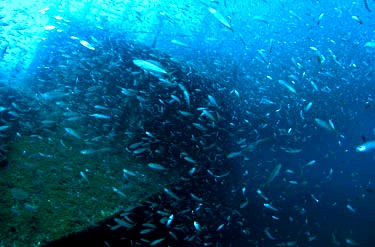 |
Florida shipwrecks are more than just a productive site to pursue snapper, grouper and amberjack. A shipwreck is a time capsule—history captured in twisted steel, eroded wood and countless artifacts that can reveal important information about a former way of life. With a rich and diverse maritime history stretching back over four centuries, Florida's shipwrecks include Spanish galleons, British warships, schooners, Confederate blockade runners, steamships and German U-boats. While many of Florida's shipwrecks have been found, the vast majority still await discovery.
Potentially over 5,000 shipwrecks reside off Florida's 1,200 miles of coastline. In and of itself, the Florida Keys archipelago, consisting of approximately 1,700 islands stretching 200 miles, is littered with the scattered remains of close to 1,000 shipwrecks. In fact, many of the reefs and shoals of the Florida Keys were named after various shipwreck events: the Marquesas Keys were named after the Marqués de Cadereita, commander of the ill-fated 1622 Fleet that included the famed Nuestra Señora de Atocha; Looe Key earned its name after the 1744 wrecking of the British frigate H.M.S. Loo; Carysfort Reef pays homage to the H.M.S. Carysfort, which ran afoul of the reef in 1770; and Alligator Reef, where the schooner U.S.S. Alligator met her fate in 1822.
It should come as no surprise that the Florida Keys are home to countless shipwrecks. The same inviting coral reefs to which divers and fishermen flock on vacation have doomed ships large and small. Historically, vessels heading south to destinations in the Caribbean or Gulf of Mexico closely hugged the Florida reefline to avoid the strong northward influence of the Gulf Stream. Unfortunately, all it took was a slight navigational error or violent afternoon squall to throw a sailing vessel onto the reef and tear her bottom out. The jagged coral reefs and treacherous shoals still wreak havoc on shipping today.
While coral reefs have sealed the fate of many vessels in South Florida and throughout the Keys, another destructive agent familiar to anyone living within the state is that of the dreaded hurricane. Hurricanes are a fact of life for Floridians. But, while we are fortunate to have satellites, radar and accurate forecasting to minimize loss of property and life, mariners prior to the mid-twentieth century were not so fortunate. Historically, hurricanes have impacted every coastal portion of the state and annually resulted in the loss of numerous vessels. In fact, the largest loss of life attributed to a single shipwreck event was due to a hurricane.
Florida's greatest maritime tragedy is probably also the least well known—the Valbanera. In late August 1919, the 400-foot-long passenger steamer Valbanera departed Spain bound for New Orleans, with stops in Puerto Rico and Cuba. As she approached Havana in early September, hurricane-force winds buffeted the ship. Unable to enter the harbor, she waited offshore overnight for the storm to pass. However, by daybreak, she was nowhere to be seen. It would be several weeks before a U.S. Navy sub-chaser would find her submerged hulk west of the Marquesas on a shoal appropriately known as the Quicksands. Almost 500 lives were lost with the sinking of the Valbanera. The 1919 hurricane responsible for sinking the Valbanera and dozens of other vessels was the third most intense storm ever to impact the United States.
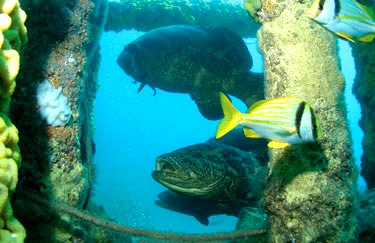 |
In contrast to the obscure sinking of the Valbanera, most readers have probably heard of the Nuestra Señora de Atocha and Mel Fisher. In September 1622, the Atocha was one of 28 vessels traveling back to Spain bulging with gold and silver from Central and South America. Only a day out of Havana, the fleet was devastated by a massive hurricane, resulting in the loss of eight ships. Debris and bodies were strewn from the Dry Tortugas to the Marquesas. In 1969, treasure hunter Mel Fisher began a 16-year quest to find the elusive wreck of the Atocha. While divers located the bulk of the galleon's treasure in 1985, work continues to this day to find the remains of the stern, where it is believed an additional cache of treasure was stored.
Aside from the Keys, there are other areas of Florida that have had more than their fair share of shipwrecks. In particular, numerous vessels have been lost in the vicinity of Cape Canaveral. The predominance of shipwrecks in this area can largely be attributed to two primary agents. The first is the naturally occurring shoals off the tip of Cape Canaveral. Ever changing and moving, vessels that strayed too close to these shallows risked becoming a permanent addition to the dangerous shoals. While many ships were easily pulled off and saved, all it took was a strong afternoon thunderstorm to potentially seal a stranded vessel's fate.
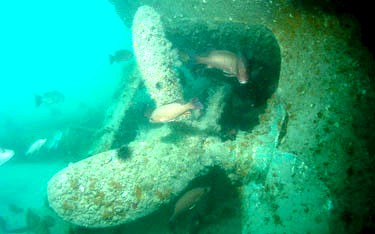 |
The other factor historically at play off Cape Canaveral was the fact that it was a bottleneck for shipping traffic. Because this point of land juts out into the Atlantic, vessels traveling north or south along the coast would invariably pass close so they could change course as appropriate and continue on their way. During World War II, German U-boats took advantage of this abundance of shipping traffic. Rather than actively hunt targets and expend their precious fuel supply, U-boats patiently waited for the targets to come to them. It didn't take long: While over 40 ships were sunk by enemy action off Florida, nowhere else off Florida is there a greater density of war casualties than the area between Port Canaveral and Sebastian Inlet. The first victim to fall to a German torpedo was the tanker Pan Massachusetts. Two days later, the tanker Cities Service Empire was sent to the bottom.
Today, these two wrecks lie in deep water less than five nautical miles apart off Cape Canaveral. Popular with anglers out of Port Canaveral, the wrecks teem with life. Until divers identified the then unknown wreck in 2001, the Pan Massachusetts was known only as the “Copper Wreck.” The first casualty of World War II lost off Florida is upside down and split in half. Only the bow portion resides off Cape Canaveral; to date, the stern section has not been found. Conversely, the 465-foot-long Cities Service Empire, known simply as the “Tanker,” is upright and intact, and provides habitat for gag, warsaw and snowy grouper, as well as abundant schools of amberjack.
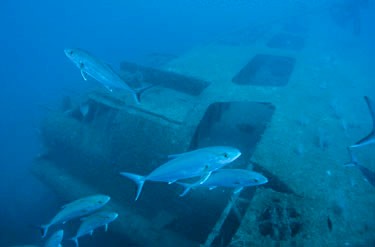 |
With so many shipwrecks lost in Florida waters, you may wonder why there aren't more shipwrecks available to fishermen and divers. While thousands of ships have sunk off Florida, many have disintegrated beyond recognition or been swallowed by the shifting sands, processes accelerated by the numerous tropical storms that annually pummel the Florida peninsula. It is likely that many of you have been frustrated to find a passing hurricane has replaced your favorite wreck with flat, barren sand. This is especially true of vessels that wrecked in shallow water and near the surf zone. Over the years, wreckage can be strewn across several miles of seafloor. Large portions of a shipwreck can be cast up on the beach and buried under sand dunes, only to be uncovered for brief periods of time by subsequent storms. While shipwrecks are slowly reclaimed by Mother Ocean, new shipwrecks do occur.
Technology has helped to prevent many groundings, at-sea collisions and storm-related sinkings. However, attrition, neglect, fire, fraud and, sometimes, simple bad luck continue to claim new shipwreck victims. Many vessels in service well past their prime and held together with duct tape, paper clips and a prayer ply waters between Florida and various Caribbean countries. One such vessel, the Honduran freighter Mary Star of the Sea, sank while at anchor off Miami in October 2000 and was eventually abandoned by her owners. She was eventually raised, towed offshore and sunk in deep water to serve as an artificial reef.
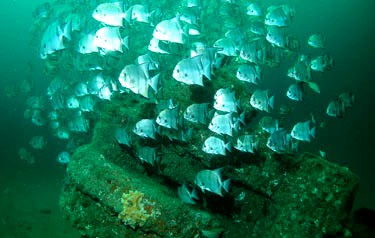 |
The same advances in technology that help to prevent future shipwreck events also allow individuals to find existing wreck sites. Whereas in the past unreliable LORAN-A and paper fathometers offered little more than a crapshoot in seeking shipwrecks, GPS satellites offering precise position information and high-resolution sonar greatly increase a fisherman's odds of locating and returning to offshore wrecks. Additional tools, such as the side-scan sonar and magnetometer, allow more comprehensive searches over a greater amount of real estate compared to more conventional methods. Regardless, it is likely that 95 percent of all shipwrecks exposed on the continental shelf have been “found” in one manner or another. Whether a shipwreck has presented a snag to trawler nets, a curious feature to oceanographers, an obstruction to navigation or a magnetic anomaly inventoried by the military, odds are someone in the past has encountered it. However, finding that data in archival files or obtaining the information from old salts can sometimes be as much an adventure as actually scanning beneath the waves from a boat bobbing on the ocean's surface.
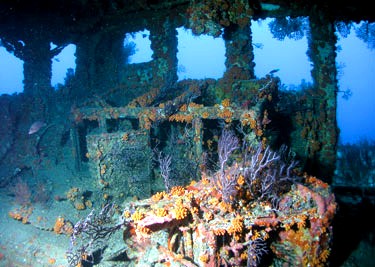 |
So, is it possible one of your honeyholes you have been fishing for years is a sunken Spanish galleon laden with gold and silver? Unlikely. However, it is quite possible one of the wrecks you fish is rich in history. The only way to find out for sure is by diving the site, plus some archeological research.
Editor's note: Michael Barnette, an avid scuba diver and relentless note-taker, is the author of Shipwrecks of the Sunshine State. The 195-page, soft-cover book relates the histories of dozens of famous and not-so-famous wrecks along our state's shores, from Spanish galleons, to World War II sinkings, to modern losses. It includes a list of over 1,000 GPS and loran coordinates. Some dive and tackle shops carry the book; you can also order it for $20 through the Web site for the Association of Underwater Explorers: www.uwex.us
FS

